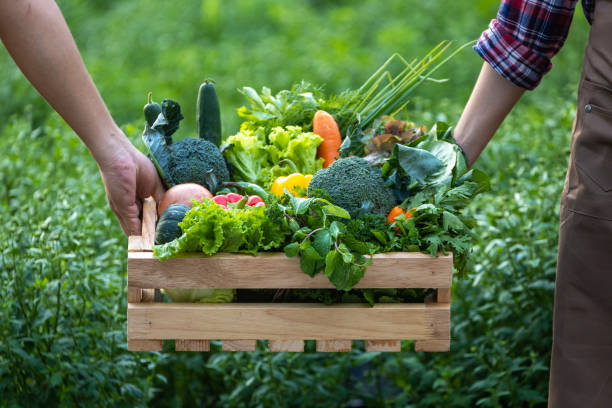Εισαγωγή
λαχανόκηπό Ο κήπος σας ανθίζει όμορφα αφού φυτέψατε αρακά, ντομάτες, κολοκυθάκια, καρότα ή φασόλια! Τώρα έρχεται το δύσκολο μέρος – η λήψη μέτρων για τη διασφάλιση της συνεχούς υγείας και ανάπτυξής τους! Αυτές οι προτάσεις θα σας βοηθήσουν να δημιουργήσετε έναν εκπληκτικό λαχανόκηπο που θα παράγει νόστιμα προϊόντα σε όλη την καλλιεργητική του περίοδο.
Αναλάβετε το ρόλο ενός ερευνητή φυτών λαχανόκηπό

Ελέγχετε συχνά τα φύλλα για σημάδια ασθένειας ή εισβολής εντόμων για να εντοπίσετε προβλήματα προτού γίνουν σοβαρά. Ρίξτε μια πιο προσεκτική ματιά στα φυτά σας όταν περπατάτε έξω για να τα απολαύσετε. Χρειάζονται μόνο λίγα λεπτά για να εξετάσετε τους μίσχους και τα φύλλα των φυτών σας για να εντοπίσετε προβλήματα με τα φυτά προτού γίνουν καταστροφικά.
Κοιτάξτε πρώτα τα φύλλα. Προσέξτε να εξετάσετε την κάτω πλευρά ορισμένων φύλλων εκτός από την κορυφή τους. Συνήθως, τα έντομα κρύβονται πίσω από το φύλλωμα. Στη συνέχεια, εξετάστε τα στελέχη. Ειδικότερα, σημειώστε πού αγγίζουν τη γη, καθώς εκεί συχνά τσιμπολογούν τα έντομα. Μολύνσεις από το πιτσίλισμα με υετό ή διάφορες μορφές σήψης των ριζών μπορούν επίσης να αναπτυχθούν κοντά στο έδαφος.
Ρίξτε λίγο αλάτι kosher στα φυτά σας
Πολλά πράσινα λαχανικά και φυτά θα μεγαλώσουν μόνο ένα στέλεχος αν αφεθούν στο δρόμο τους. Για όσους επιλέγουν να καταναλώσουν τα φύλλα τους, αυτό δεν είναι τόσο ωφέλιμο όσο είναι για τη διατήρηση των μίσχων των λουλουδιών αυτών των φυτών. Για να αυξήσουν τον αριθμό των στελεχών και των φύλλων, οι κηπουροί «τσιμπούν» το κύριο στέλεχος κόβοντάς το πίσω στο επάνω σετ φύλλων.
Πολλά φυτά θα παράγουν δύο νέους μίσχους όταν τσιμπήσετε τον κύριο, αυξάνοντας το δυναμικό μέγεθος του φυτού σας και καθιστώντας εύκολη και αποτελεσματική την προετοιμασία των λαχανικών Βρυξελλών με πολλά βότανα όπως βασιλικό, λεβάντα, ρίγανη, δεντρολίβανο, φασκόμηλο, εστραγκόν και θυμάρι.
Βγάλε αυτό το τράνταγμα από εκεί
λαχανόκηπό Πρέπει να κόψετε τα «κορόιδα», ή τα περίεργα ενδιάμεσα στελέχη που αναπτύσσονται μεταξύ του κύριου μίσχου του φυτού της ντομάτας και των πλευρικών κλαδιών του, αν θέλετε τις μεγαλύτερες, πιο γλυκές ντομάτες. Προεξέχουν σε διαστήματα 45 μοιρών.
Οι ντομάτες σας δεν θα βλάψουν τα κορόιδα και τελικά θα παράγουν φρούτα, λουλούδια και φύλλα. Ωστόσο, μειώνουν την κυκλοφορία του αέρα και τη διείσδυση του φωτός στα κάτω φύλλα, γεγονός που μπορεί να αυξήσει την ευαισθησία των φυτών ντομάτας σας σε μυκητιασικές λοιμώξεις.
Η πιθανότητα απορρόφησης φυτικών ασθενειών από το περιβάλλον έδαφος αυξάνεται από τα κορόιδα κοντά στη βάση του στελέχους, ιδιαίτερα εάν πιτσιλιστούν κατά τη διάρκεια μιας νεροποντής. Είναι επίσης δύσκολο να παρατηρήσετε τυχόν προβλήματα που μπορεί να δημιουργηθούν στο φυτό σας.
Ασφαλίστε τους λαχανόκηπό

Σίγουρα, οι εικόνες στα παιδικά σας βιβλία απεικονίζουν κατάφυτα μπαλώματα από κολοκύθες με κληματαριές να πέφτουν στο έδαφος, αλλά δεν δείχνουν τα παιδιά και τα σκυλιά σας να σκοντάφτουν πάνω από τα κλήματα και να ποδοπατούν τα κολοκυθάκια ή τους γυμνοσάλιαγκες και τα ζωύφια που απολαμβάνουν ανακαλύπτοντας ζουμερά λαχανικά στο ύψος των ματιών τους.
λαχανόκηπό Σκεφτείτε να καλλιεργήσετε τα φρούτα ή τα λαχανικά σας που αμπελώνετε κάθετα, όπως πεπόνια, κολοκύθες, κολοκύθες ή αγγούρια, σε μια πέργκολα όπως αυτή η πέργκολα με πλαίσιο Α ή σε κοντάρι ή κλουβί. Θα διατηρήσει τον πολύτιμο χώρο του κήπου σας, θα σας γλιτώσει από την αγωνία του ποδοπάτημα των αγαπημένων φυτών και βελτιώνοντας την κυκλοφορία του αέρα, θα μειώσει τις ασθένειες και τις ζημιές από έντομα.
Συγκεντρώστε λαχανικά όταν είναι μικρά
Όταν τα λαχανικά είναι ακόμα νέα και γευστικά, μαζέψτε τα προτού γίνουν ογκώδη, ήπια τέρατα.
Η καλλιέργεια μεγαλύτερων λαχανικών στο σπίτι δεν είναι ωφέλιμη – οι λοβοί φασολιών με υπερώριμα και φασόλια, μεγάλες ξυλώδεις μπάμιες και κολοκυθάκια στο μέγεθος ενός ρόπαλου του μπέιζμπολ χωρίς γεύση μπορούν γρήγορα να γίνουν ελκυστικά για τους περισσότερους καταναλωτές.
Όχι μόνο τα παλαιότερα λαχανικά είναι συχνά υπερβολικά ινώδη και δύσκολα καταναλώνονται, αλλά συχνά προσελκύουν παράσιτα όπως μυρμήγκια, σφήκες και σκίουρους που τρέφονται με τα υπερώριμα προϊόντα σας πριν προχωρήσουν σε πιο ευαίσθητες νεότερες καλλιέργειες ως δεύτερο πιάτο!
Η απάντηση είναι να μαζέψετε τα λαχανικά σας μόλις γίνουν έτοιμα. Ένας χρήσιμος οδηγός από το Πανεπιστήμιο της Τζόρτζια δείχνει πότε πρέπει να συλλέγετε δημοφιλή λαχανικά, υποδεικνύοντας πότε είναι ώριμα, υποώριμα και έχουν περάσει την ακμή τους.
Βεβαιωθείτε ότι καταναλώνουν επαρκές νερό λαχανόκηπό

Το νερό είναι απαραίτητο για τα φυτά και τα φυτά που παρέχουν λαχταριστούς καρπούς, όπως οι ντομάτες, απαιτούν σταθερή παροχή. Όταν οι ντομάτες λαμβάνουν λιγότερο από μία ίντσα νερό κάθε εβδομάδα, αναπτύσσουν σήψη των ανθέων, η οποία μετατρέπει τις κατά τα άλλα πανέμορφες, ώριμες ντομάτες από κάτω προς τα πάνω σε καφέ χυλό.
Αποτρέψτε αυτό να συμβεί στον κήπο σας μετρώντας πόσο νερό της βροχής πέφτει πάνω του με ένα βροχόμετρο και ποτίζοντας φυτά λαχανικών εάν πέφτει λιγότερο από μία ίντσα κάθε εβδομάδα.
Μια πλήρης συνεδρία ποτίσματος την εβδομάδα αντί για συνεχή ομίχλη θα κάνει τα φυτά σας πιο υγιή. Κάνοντας αυτό τους επιτρέπει να διατηρήσουν τυχόν υπολειμματική υγρασία που μπορεί να χρειάζονται ακόμα.
Ωστόσο, μην ταΐζετε υπερβολικά τα φυτά σας
Τα φυτά χρειάζονται θρεπτικά συστατικά, χημικές ουσίες και μέταλλα, τα οποία βρίσκονται φυσικά σε πλούσια εδάφη κήπου, για να ανθίσουν. Η απορροή από το επιθετικό χημικό λίπασμα που χρησιμοποιούν πολλοί ερασιτέχνες κηπουροί είναι κάτι που δεν χρειάζονται.
Ακόμη χειρότερα, τα φυτά σας μπορεί να υποστούν βλάβη από υπερβολική ποσότητα χημικού λιπάσματος. Η υπερβολική χρήση αζωτούχου λιπάσματος αναγκάζει τα φυτά να παύουν να παράγουν άνθη, φρούτα ή ρίζες και αντί να παράγουν γρήγορα φύλλα και αμπέλια. Τα καρότα και οι ντομάτες λένε αντίο! Η περίσσεια φωσφόρου μπορεί να προκαλέσει χλώρωση, οδηγώντας σε κιτρινισμένα φύλλα στα φυτά και μειώνοντας την ικανότητά τους να φωτοσυνθέτουν.
Δοκιμάστε το χώμα σας πριν εφαρμόσετε λίπασμα στα φυτά σας, ιδανικά πριν φυτέψετε τον κήπο σας. Μπορείτε να λάβετε δοκιμές από τα τοπικά γραφεία γεωργικής επέκτασης για περίπου $10 έως $20, και θα σας πουν ποια ποσά.
Βγάλε την αντιπολίτευση
Χρησιμοποιώντας μια στιβαρή σκαπάνη κήπου ή μια ιαπωνική σκαπάνη χειρός, μπορείτε να αφαιρέσετε τα φύλλα από τις ρίζες των μικροσκοπικών ζιζανίων. Εάν πρέπει να αφαιρέσετε ένα καλά εγκατεστημένο φυτό με δυνατές ρίζες μετά από κάποιο χρονικό διάστημα, ένα βοτανοκόμμα CobraHead μπορεί να σας βοηθήσει να κολλήσετε από κάτω.

